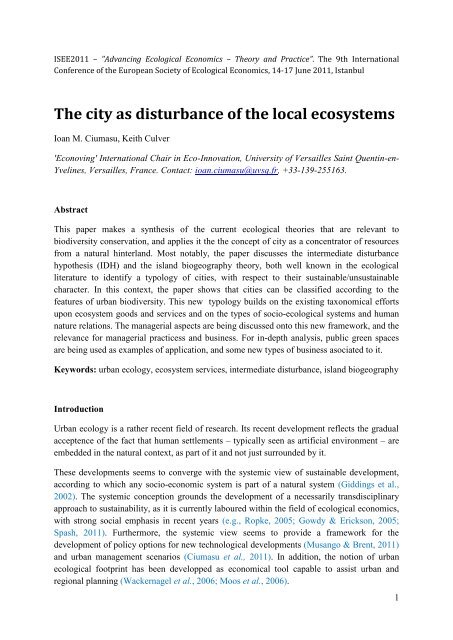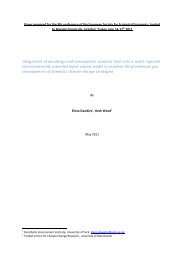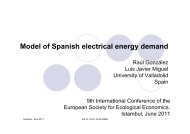The city as disturbance of the local ecosystems - ESEE 2011 ...
The city as disturbance of the local ecosystems - ESEE 2011 ...
The city as disturbance of the local ecosystems - ESEE 2011 ...
You also want an ePaper? Increase the reach of your titles
YUMPU automatically turns print PDFs into web optimized ePapers that Google loves.
ISEE<strong>2011</strong> – "Advancing Ecological Economics – <strong>The</strong>ory and Practice”. <strong>The</strong> 9th International<br />
Conference <strong>of</strong> <strong>the</strong> European Society <strong>of</strong> Ecological Economics, 14-17 June <strong>2011</strong>, Istanbul<br />
<strong>The</strong> <strong>city</strong> <strong>as</strong> <strong>disturbance</strong> <strong>of</strong> <strong>the</strong> <strong>local</strong> <strong>ecosystems</strong><br />
Ioan M. Cium<strong>as</strong>u, Keith Culver<br />
'Econoving' International Chair in Eco-Innovation, University <strong>of</strong> Versailles Saint Quentin-en-<br />
Yvelines, Versailles, France. Contact: ioan.cium<strong>as</strong>u@uvsq.fr, +33-139-255163.<br />
Abstract<br />
This paper makes a syn<strong>the</strong>sis <strong>of</strong> <strong>the</strong> current ecological <strong>the</strong>ories that are relevant to<br />
biodiversity conservation, and applies it <strong>the</strong> <strong>the</strong> concept <strong>of</strong> <strong>city</strong> <strong>as</strong> a concentrator <strong>of</strong> resources<br />
from a natural hinterland. Most notably, <strong>the</strong> paper discusses <strong>the</strong> intermediate <strong>disturbance</strong><br />
hypo<strong>the</strong>sis (IDH) and <strong>the</strong> island biogeography <strong>the</strong>ory, both well known in <strong>the</strong> ecological<br />
literature to identify a typology <strong>of</strong> cities, with respect to <strong>the</strong>ir sustainable/unsustainable<br />
character. In this context, <strong>the</strong> paper shows that cities can be cl<strong>as</strong>sified according to <strong>the</strong><br />
features <strong>of</strong> urban biodiversity. This new typology builds on <strong>the</strong> existing taxonomical efforts<br />
upon ecosystem goods and services and on <strong>the</strong> types <strong>of</strong> socio-ecological systems and human<br />
nature relations. <strong>The</strong> managerial <strong>as</strong>pects are being discussed onto this new framework, and <strong>the</strong><br />
relevance for managerial practicess and business. For in-depth analysis, public green spaces<br />
are being used <strong>as</strong> examples <strong>of</strong> application, and some new types <strong>of</strong> business <strong>as</strong>ociated to it.<br />
Keywords: urban ecology, ecosystem services, intermediate <strong>disturbance</strong>, island biogeography<br />
Introduction<br />
Urban ecology is a ra<strong>the</strong>r recent field <strong>of</strong> research. Its recent development reflects <strong>the</strong> gradual<br />
acceptence <strong>of</strong> <strong>the</strong> fact that human settlements – typically seen <strong>as</strong> artificial environment – are<br />
embedded in <strong>the</strong> natural context, <strong>as</strong> part <strong>of</strong> it and not just surrounded by it.<br />
<strong>The</strong>se developments seems to converge with <strong>the</strong> systemic view <strong>of</strong> sustainable development,<br />
according to which any socio-economic system is part <strong>of</strong> a natural system (Giddings et al.,<br />
2002). <strong>The</strong> systemic conception grounds <strong>the</strong> development <strong>of</strong> a necessarily transdisciplinary<br />
approach to sustainability, <strong>as</strong> it is currently laboured within <strong>the</strong> field <strong>of</strong> ecological economics,<br />
with strong social emph<strong>as</strong>is in recent years (e.g., Ropke, 2005; Gowdy & Erickson, 2005;<br />
Sp<strong>as</strong>h, <strong>2011</strong>). Fur<strong>the</strong>rmore, <strong>the</strong> systemic view seems to provide a framework for <strong>the</strong><br />
development <strong>of</strong> policy options for new technological developments (Musango & Brent, <strong>2011</strong>)<br />
and urban management scenarios (Cium<strong>as</strong>u et al., <strong>2011</strong>). In addition, <strong>the</strong> notion <strong>of</strong> urban<br />
ecological footprint h<strong>as</strong> been developped <strong>as</strong> economical tool capable to <strong>as</strong>sist urban and<br />
regional planning (Wackernagel et al., 2006; Moos et al., 2006).<br />
1
However, urban ecology is a very new sub-discipline. Despite signs <strong>of</strong> convergence towards<br />
<strong>the</strong> syn<strong>the</strong>tic effort <strong>of</strong> ecological economics and sustaianbility studies, itself a new endeavour,<br />
it is highly uncertain on which b<strong>as</strong>es <strong>the</strong> connection will be made between <strong>the</strong> two. For<br />
example, since <strong>the</strong> beginning <strong>of</strong> <strong>the</strong> 21st century, cities are being regarded <strong>as</strong> knowledge and<br />
technology hubs and socio-economic engines, both individually and within a global urban<br />
network (Beaverstock et al., 2000). We also know that "nature in <strong>the</strong> <strong>city</strong>” (most notably<br />
green spaces) is a meaningful issue, <strong>as</strong> reflected in <strong>the</strong> efforts on urban ecosystem goods and<br />
services (Bolund & Hunhammar, 1999). But what is actually <strong>the</strong> place <strong>of</strong> <strong>the</strong> <strong>city</strong> from an<br />
ecological perspective?<br />
Urban ecology can be defined <strong>as</strong> „<strong>the</strong> interaction <strong>of</strong> social and ecological systems within<br />
urbanized space and <strong>the</strong> impact such interactions have on external systems” (Young, 2009).<br />
As such, within <strong>the</strong> environment, <strong>the</strong> <strong>city</strong> h<strong>as</strong> a clearly identifiable identity, a set <strong>of</strong> features<br />
that makes it a socio-ecological system and <strong>the</strong>nce distinguishes it from <strong>the</strong> surrounding<br />
environement. <strong>The</strong> question now is: How does this social-ecological system, in deed a colony<br />
<strong>of</strong> our species, fit within <strong>the</strong> wider ecological systems? What is, ecologically speaking, this<br />
Homo sapiens’ colony called "<strong>city</strong>”? This is <strong>the</strong> concern <strong>of</strong> <strong>the</strong> present communication, which<br />
attempts to provide some <strong>the</strong>oretical ground for future answers.<br />
Proposed conceptual approach<br />
On <strong>the</strong> grounds <strong>of</strong> current ecological <strong>the</strong>ory, <strong>the</strong> folowing hypo<strong>the</strong>sis can be formulated/used:<br />
Within a given ecosystem or continuum <strong>of</strong> <strong>ecosystems</strong>, any given <strong>city</strong> is a <strong>disturbance</strong>. <strong>The</strong><br />
term '<strong>disturbance</strong>' is used with its ecological meaning <strong>of</strong> perturbation <strong>of</strong> ecologically<br />
describable ecosystem dynamics. As <strong>the</strong> factor <strong>of</strong> this <strong>disturbance</strong> is obviously <strong>the</strong> presence <strong>of</strong><br />
<strong>the</strong> species Homo sapience in a <strong>local</strong>ly high density <strong>of</strong> individuals, <strong>the</strong> <strong>city</strong> becomes <strong>the</strong> most<br />
prominent c<strong>as</strong>e <strong>of</strong> <strong>the</strong> wider situation <strong>of</strong> <strong>the</strong> occurence <strong>of</strong> human settlements (colonies, from<br />
an ecological perspective). <strong>The</strong> hypo<strong>the</strong>sis can bear a generalized form – Within a given<br />
ecosystem or continuum <strong>of</strong> <strong>ecosystems</strong>, any given human settlement (or colony) is a<br />
<strong>disturbance</strong> – and should be treated <strong>as</strong> such from an ecological <strong>the</strong>oretical perspective.<br />
Results – <strong>the</strong>oretical consequences<br />
A major path to understand <strong>ecosystems</strong> structure and function (and ultimately ecosystem<br />
services) is via biodiversity proxies. To date, <strong>the</strong>re exist no unified biodiversity <strong>the</strong>ory <strong>of</strong><br />
biodiversity, but several major <strong>the</strong>ories are enduringly successful in predicting a large amount<br />
<strong>of</strong> patterns found in nature. One is <strong>the</strong> cl<strong>as</strong>sical equilibrium <strong>the</strong>ory <strong>of</strong> Island Biogeography<br />
(IB), stating that biodiversity in a given teritory (originally illustated by islands in <strong>the</strong><br />
planetary ocean) is a direct result <strong>of</strong> <strong>the</strong> dynamic equilibrium between <strong>the</strong> immigation <strong>of</strong> new<br />
species and <strong>the</strong> extinction <strong>of</strong> <strong>the</strong> species already present <strong>the</strong>re, which in turn depend on<br />
physical distances and <strong>local</strong> ecological processes like competition between species<br />
(MacArthur & Wilson, 1967; Simberl<strong>of</strong>f, 1974; Kadmon & Allouche, 2007). Ano<strong>the</strong>r is <strong>the</strong><br />
2
Intermediate Disturbance Hypo<strong>the</strong>sis (IDH), a line <strong>of</strong> thought stating that, at a given location,<br />
<strong>the</strong> highest levels <strong>of</strong> biodiversity occur at intermediate levels (intensity and frequency) <strong>of</strong><br />
<strong>disturbance</strong>. This phenomenon h<strong>as</strong> been observed empirically but is hard to test, since it can<br />
result from very different processes (Wilson, 1990; Roxburgh et al., 2004). <strong>The</strong> two <strong>the</strong>ories<br />
complete each o<strong>the</strong>r, IB being more useful for large scale patterns and IDH at <strong>local</strong> scales.<br />
Given <strong>the</strong> both global and <strong>local</strong> relevance <strong>of</strong> cities, <strong>the</strong> two ecological <strong>the</strong>ories need to be<br />
taken into account when trying to understand <strong>the</strong> relation between a <strong>city</strong> and <strong>ecosystems</strong>. By<br />
regarding a given <strong>city</strong> (or a human settlement in general) <strong>as</strong> a <strong>disturbance</strong>, it immediately<br />
follows that (i) cities <strong>of</strong> various sizes may have interestingly different impacts on <strong>ecosystems</strong>,<br />
and (ii) that <strong>the</strong> ranges <strong>of</strong> <strong>the</strong>se impacts are being determined by <strong>the</strong> position <strong>of</strong> <strong>the</strong> <strong>city</strong> within<br />
<strong>the</strong> continental and global biogeography. <strong>The</strong> first point identifies <strong>the</strong> <strong>local</strong> ecological issue,<br />
and constitutes <strong>the</strong> focus <strong>of</strong> this papers, while <strong>the</strong> second defines its ecological context.<br />
Notably, point (i) implies <strong>the</strong> existence <strong>of</strong> three categories <strong>of</strong> human settlements (HS),<br />
corresponding to <strong>the</strong> three levels <strong>of</strong> <strong>disturbance</strong> intensity according to IDH: low, intermediate<br />
and high. At <strong>the</strong> level <strong>of</strong> geological time, three categories can be identified, though less<br />
intuitive, correspondig to <strong>the</strong> <strong>disturbance</strong> frequency: low, intermediate, and high. For<br />
simpli<strong>city</strong> purposes, this communication will focus on <strong>the</strong> intensity, but <strong>the</strong> time is still taken<br />
into account, <strong>as</strong> <strong>the</strong> simple duration <strong>of</strong> <strong>the</strong> <strong>disturbance</strong> (in social terms, <strong>the</strong> lifetime <strong>of</strong> a <strong>city</strong>).<br />
For cities, <strong>the</strong>se categories can be observed both at <strong>the</strong> level <strong>of</strong> <strong>city</strong> units (a big <strong>city</strong> generates<br />
a big impact) and at <strong>the</strong> level <strong>of</strong> <strong>disturbance</strong> intensity on a gradient from <strong>city</strong> perifery to <strong>city</strong><br />
centre (Table 1). This typology does not indicate what <strong>the</strong> absolute value <strong>of</strong> <strong>the</strong> <strong>disturbance</strong><br />
intensity is, but it also does not need to, since this vary with context and can be identified at a<br />
latter stage for management purposes, <strong>as</strong> applied to a chosen <strong>city</strong>. However, <strong>the</strong> typology<br />
points out to <strong>the</strong> existence <strong>of</strong> a natural taxonomy <strong>of</strong> urban are<strong>as</strong> (<strong>as</strong> socio-economic systems)<br />
with respect to <strong>the</strong>ir ecological place in <strong>the</strong> natural system into which <strong>the</strong>y are embedded,<br />
according to <strong>the</strong> systemic view on <strong>the</strong> sustainability <strong>of</strong> human activity on Earth.<br />
A typology <strong>of</strong> management objectives is also identifiable, <strong>as</strong> to account for <strong>the</strong> different<br />
ecological impact that periferic and central are<strong>as</strong> may have on <strong>ecosystems</strong>. Also, <strong>the</strong> typology<br />
allows for natural (ecologically-relevant) boundaries to be established between periferic, nearcentral<br />
and central are<strong>as</strong> <strong>of</strong> a <strong>city</strong>, in relation to <strong>the</strong> <strong>local</strong> set <strong>of</strong> ecological constraints and<br />
limitations.<br />
Table 1 – Typology <strong>of</strong> urban are<strong>as</strong>, <strong>as</strong> derived from <strong>the</strong> IDH<br />
Disturbance intensity City unit City area (on a centrifugal axis)<br />
low small <strong>city</strong> <strong>city</strong> perifery<br />
intermediate medium size <strong>city</strong> <strong>city</strong> near-central<br />
high large <strong>city</strong> <strong>city</strong> centre<br />
3
Fur<strong>the</strong>r, for any <strong>city</strong> (urban unit), <strong>the</strong> ecological pr<strong>of</strong>ile can be described on a managementrelevant<br />
gradient <strong>of</strong> <strong>disturbance</strong> intensity. Thus, during <strong>the</strong> life span <strong>of</strong> a <strong>city</strong> (<strong>the</strong> century or<br />
<strong>the</strong> decade can be used <strong>as</strong> relevant time units), its impact upon <strong>the</strong> environment varies: it first<br />
goes through a period <strong>of</strong> incre<strong>as</strong>ing impact, <strong>the</strong>n it experiences a period <strong>of</strong> maximum impact,<br />
and <strong>the</strong>n enters a period <strong>of</strong> decre<strong>as</strong>ing impact. From <strong>the</strong> socio-economic perspective, <strong>the</strong>se<br />
stages can be described <strong>as</strong> <strong>the</strong> rising period, <strong>the</strong> golden age, and <strong>the</strong> decline. In this c<strong>as</strong>e, <strong>the</strong><br />
environmental impact varies proportionally with <strong>the</strong> socio-economic development, and can be<br />
<strong>the</strong>refore considered a proxy for <strong>city</strong> life stages. Thus, socio-economic success is just<br />
indicated by how much water is extracted, how much wood is burned, or similar me<strong>as</strong>ures<br />
that can be understood <strong>as</strong> indicators <strong>of</strong> economic activity.<br />
Now, <strong>the</strong> most interesting part <strong>of</strong> this evolution is <strong>the</strong> peak that corresponds to <strong>the</strong> golden age<br />
in a <strong>city</strong>’s lifetime. Figure 1 illustrates five <strong>the</strong>oretical categories <strong>of</strong> <strong>disturbance</strong> intensity. For<br />
<strong>the</strong> sake <strong>of</strong> conceptual clarity, necessary for this introduction to <strong>the</strong> concept, <strong>the</strong> <strong>city</strong> lifespan<br />
is considered to be identical in all c<strong>as</strong>es, <strong>the</strong>nce <strong>the</strong> symetrical trajectories <strong>of</strong> <strong>the</strong> <strong>disturbance</strong><br />
intensities.<br />
Disturbance intensity [d]<br />
5<br />
4<br />
3<br />
2<br />
1<br />
0<br />
0 2 4 6 8 10 12 14 16<br />
City life time [t]<br />
Figure 1 – Typology <strong>of</strong> cities’ lifetime, <strong>as</strong> derived from <strong>the</strong> IDH and <strong>the</strong> concept <strong>of</strong> ecosystem<br />
carrying capa<strong>city</strong>. Disturbance intensity d1 corresponds to <strong>the</strong> ecological carrying capa<strong>city</strong><br />
that is available to a <strong>city</strong>, correponding to a critical "no return point" meaning a threshold<br />
which, if crossed, triggers a decre<strong>as</strong>e <strong>of</strong> <strong>the</strong> absolute value <strong>of</strong> <strong>the</strong> ecosystem carrying<br />
capa<strong>city</strong>. If not crossed, <strong>the</strong> respective carrying capa<strong>city</strong> is regenerable. Fur<strong>the</strong>r, d2, d3, d4<br />
correspond to <strong>the</strong> level where a <strong>city</strong> h<strong>as</strong> already engaged on a path <strong>of</strong> degradation <strong>of</strong> <strong>the</strong><br />
carrying cap<strong>city</strong> available to it, but <strong>the</strong> speed <strong>of</strong> that degradation can be accelerated once<br />
varios thresholds are being crossed.<br />
4
Discussions – consequences for urban planning<br />
When <strong>local</strong> factors and me<strong>as</strong>ures are factored in, <strong>the</strong> concept described above allow definition<br />
and quantification <strong>of</strong> important parameters like <strong>city</strong> resilience and vulnerability. This also<br />
alows a more structured discussion on <strong>the</strong> role <strong>of</strong> cities in <strong>the</strong> transition to sustainability.<br />
Cities cannot be sustainable per se, but only within <strong>the</strong> wider hinterland. On <strong>the</strong> one hand, this<br />
is why IB <strong>the</strong>ory becomes important with <strong>the</strong> size <strong>of</strong> <strong>the</strong> hinterland. On <strong>the</strong> o<strong>the</strong>r hand, this is<br />
why <strong>the</strong> concept <strong>of</strong> eco-<strong>city</strong> is more appropriate in <strong>the</strong> discussion between urban are<strong>as</strong> and<br />
transition to sustainability. It is not possible to decide whe<strong>the</strong>r a <strong>city</strong> is sustainable or not.<br />
Instead, me<strong>as</strong>ures can be found to estimate how close it is to <strong>the</strong> objective <strong>of</strong> sustainability.<br />
Various urban ecological me<strong>as</strong>ures can be used <strong>as</strong> proxies and indicators <strong>of</strong> <strong>the</strong> variation <strong>of</strong><br />
<strong>the</strong> <strong>disturbance</strong> intensity by/in urban are<strong>as</strong>, like urban biodiversity indicators or energetic<br />
me<strong>as</strong>ures related to <strong>the</strong> urban heat island effect. In this context, progress in <strong>the</strong> transition to<br />
sustainability through innovative and integrative techno-social-economic-ecologic-managerial<br />
actions will not be me<strong>as</strong>ured in absolute terms (it would not be possible), but in <strong>the</strong> relative<br />
terms <strong>of</strong> progress from one level <strong>of</strong> <strong>city</strong> impact upon <strong>the</strong> environment to <strong>the</strong> lesser one. In this<br />
c<strong>as</strong>e, innovation is eco-innovation, <strong>the</strong> innovation process which results in lesser impact <strong>of</strong><br />
human activities upon <strong>the</strong> environment.<br />
In this context, a provision is germane to <strong>the</strong> role <strong>of</strong> urban green are<strong>as</strong>, <strong>as</strong> this is one major<br />
avenue <strong>of</strong> "greening" <strong>the</strong> cities. <strong>The</strong> dynamic <strong>of</strong> green spaces in European cities appear to be<br />
more correlated with <strong>city</strong> surface size than with population density, signalling a continuing<br />
compaction <strong>of</strong> urban are<strong>as</strong> in <strong>the</strong> future (Fuller & G<strong>as</strong>ton, 2009). If <strong>city</strong> compaction will<br />
continue, <strong>as</strong> it seems, <strong>the</strong> impact <strong>of</strong> <strong>the</strong> <strong>city</strong> opon <strong>ecosystems</strong> outside <strong>the</strong> <strong>city</strong> perimeter will<br />
incre<strong>as</strong>e. Ra<strong>the</strong>r than understanding future cities in terms <strong>of</strong> green are<strong>as</strong> per inhabitant within<br />
<strong>the</strong> perimeter <strong>of</strong> a <strong>city</strong>, urban management will have to consider (1) <strong>the</strong> ecological role <strong>of</strong> <strong>the</strong><br />
<strong>city</strong> within its hinterland (and, <strong>as</strong> a hub <strong>of</strong> a global network <strong>of</strong> cities, also <strong>as</strong> part <strong>of</strong> <strong>the</strong><br />
bioshpere) according to an ecologically relevant typology and dynamics, and (2), <strong>the</strong> spatial<br />
structure <strong>of</strong> <strong>the</strong> <strong>city</strong> along a centre-perifery axis.<br />
<strong>The</strong> concept presented hereby allows apt managerial links to notions <strong>of</strong> ecological footprint,<br />
carrying capa<strong>city</strong>, and urban 'optimization' and fitting modes <strong>of</strong> living to environments. It may<br />
be especially interesting to consider this approach <strong>as</strong> a general <strong>the</strong>oretical ground which will<br />
enable a more reflective <strong>as</strong>sessment <strong>of</strong> just what kind <strong>of</strong> density <strong>of</strong> inhabitants is appropriate<br />
to what kind <strong>of</strong> <strong>city</strong> and ecosystem service. <strong>The</strong> zest for one-size-fits-all futuristic projects<br />
risks obscuring or impairing careful thinking about <strong>the</strong> diverse ways in which cities <strong>of</strong> <strong>the</strong><br />
future might be structured in light <strong>of</strong> <strong>the</strong>ir particular ecological locations, links to trade routes<br />
with specific ecological services and values and costs, and related factors.<br />
References:<br />
Bolund P, Hunhammar S (1999). Ecosystem services in urban are<strong>as</strong>. Ecological Economics<br />
29(2): 293-301.<br />
5
Beaverstock JV, Smith RG, Taylor PJ (2000). World-City Network: A New Metageography?<br />
Annals <strong>of</strong> <strong>the</strong> Association <strong>of</strong> American Geographers 90(1): 123-134.<br />
Cium<strong>as</strong>u IM (<strong>2011</strong>). Complex risks from old urban w<strong>as</strong>te landfills - a sustainability<br />
perspective from I<strong>as</strong>i, Romania. Journal <strong>of</strong> Hazardous, Toxic and Radioactive W<strong>as</strong>te, in print.<br />
Fuller RA, G<strong>as</strong>ton KJ (2009). <strong>The</strong> scaling <strong>of</strong> green space coverage in European cities. Biology<br />
Letters 5: 352-355.<br />
Giddings B, Hopwood B, O’Brien G (2002). Environment, economy and society: fitting <strong>the</strong>m<br />
toge<strong>the</strong>r into sustainable development. Sustainable Development 10(4): 187-196.<br />
Gowdy J, Erickson JD (2005). <strong>The</strong> approach <strong>of</strong> ecological economics. Cambridge Journal <strong>of</strong><br />
Economics 29: 207-222.<br />
MacArthur RH, Wilson EO (1967). <strong>The</strong> <strong>The</strong>ory <strong>of</strong> Island Biogeography. Princeton, NJ:<br />
Princeton University Press. 203 pp.<br />
Musango JK, Brent AC (2010). A conceptual framework for energy technology sustainability<br />
<strong>as</strong>sessment. Energy for Sustainable Development 15(1): 84-91.<br />
Moos M, Whitfield J, Johnson LC, Andrey J (2006). Does Design Matter? <strong>The</strong> Ecological<br />
Footprint <strong>as</strong> a Planning Tool at <strong>the</strong> Local Level. Journal <strong>of</strong> Urban Design 11(2): 195-22.<br />
Ropke I (2005). Trends in <strong>the</strong> development <strong>of</strong> ecological economics from <strong>the</strong> late 1980s to <strong>the</strong><br />
early 2000s. Ecological Economics 55(2): 262-290.<br />
Roxburgh S, Shea K, Wilson JB (2004). <strong>The</strong> intermediate <strong>disturbance</strong> hypo<strong>the</strong>sis: patch<br />
dynamics and mechanisms <strong>of</strong> species coexistence. Ecology 85(2): 359-371.<br />
Simberl<strong>of</strong>f DS (1974) Equilibrium <strong>The</strong>ory <strong>of</strong> Island Biogeography and Ecology. Annual<br />
Review <strong>of</strong> Ecology and Systematics 5: 161-182.<br />
Sp<strong>as</strong>h C (<strong>2011</strong>). Social ecological economics: understanding <strong>the</strong> p<strong>as</strong>t to see <strong>the</strong> future.<br />
American Journal <strong>of</strong> Economics and Sociology 70(2): 340–375.<br />
Young RF (2009). Interdisciplinary foundations <strong>of</strong> urban ecology. Urban Ecosystems 12: 311-<br />
331.<br />
Wackernagel M, Kitzes J, Moran D, Goldfinger S, Thom<strong>as</strong> M (2006). <strong>The</strong> Ecological<br />
Footprint <strong>of</strong> cities and regions: comparing resource availability with resource demand.<br />
Environment & Urbanization 18(1): 103-112.<br />
Wilson JB (1990). Mechanisms <strong>of</strong> species coexistence: twelve explanations for Hutchinson’s<br />
"paradox <strong>of</strong> <strong>the</strong> plankton": evidence from New Zealand plant communities. New Zealand<br />
Journal <strong>of</strong> Ecology 13: 17-42.<br />
6







